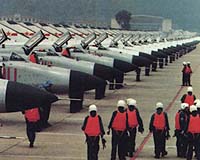 |
Washington (AFP) May 23, 2006
The pace and scope of China's modernization of its strategic forces and other surprising military developments could pose a credible long-term threat to the United States, the Pentagon warned Tuesday.
In an annual report to Congress, the Defense Department said China's ability to sustain military power at a distance is limited, but it has the greatest potential of any nation to compete militarily with the United States.
"Several aspects of China's military development have surprised US analysts, including the pace and scope of its strategic forces modernization," an executive summary of the report said.
"China's military expansion is already such as to alter regional military balances," it added.
"Long-term trends in China's strategic nuclear forces modernization, land- and sea-based access denial capabilities, and emerging precision-strike weapons have the potential to pose credible threats to modern militaries operating in the region," the report said.
The annual China military power report is a closely watched barometer of military relations between the Asian power and the United States, the dominant military power in the Asia Pacific region.
The report made waves last year by calling attention to big, unacknowledged increases in Chinese spending on a major military buildup that it said put at risk the military balance in the region.
The latest report expanded on that theme and said China had still not adequately explained "the purposes or desired end-stats of their military expansion."
"Absent greater transparency, international reactions to China's military growth will understandably hedge against these unknowns," the report said.
It estimated China's true military spending at 70 to 105 billion dollars a year -- two to three times the 35 billion-dollar defense budget announced by China.
US intelligence, however, estimates it will take China until the end of the decade or later to produce a military capable of defeating a moderate-size enemy, the report said.
In the near term, China appears focused on preparing for contingencies in the Taiwan Strait, including the possibility of US intervention, the report said.
China now has an estimated 710 to 790 short-range missiles opposite Taiwan, and adding new ones at a rate of about 100 a year, according to the report.
Its approach to Taiwan centers of developing ways to prevent the US from intervening militarily, the report said.
"For example, evidence suggests the (People's Liberation Army) is engaged in a sustained effort to interdict, at long ranges, aircraft carrier and expeditionary strike groups that might deploy to the western Pacific," the report said.
It said China was apparently investing in medium-range missiles, high-tech communications and guidance systems "to strike surface ships on the high seas or their onshore support infrastructure."
"A layered system to achieve local sea denial would also employ submarines, maritime strike aircraft and modern surface combatants equipped with anti-ship cruise missiles," it said.
At the same time, China is upgrading its longer-range ballistic missile force and replacing older systems with newer, more survivable ones, according to the report.
These include a new road-mobile intercontinental ballistic missile, the DF-31 and the extended-range DF-31A, which can target the continental United States and most of the rest of the world, the report said.
They are supplemented by a new submarine launched ballistic missile, the JL-2.
Citing a July 2005 warning by a Chinese general that China would have no choice but to use nuclear weapons if the United States targeted China, said internal debate on China's policy of "no first use" of nuclear weapons was broader than previously thought.
The report singled out Russia as the source of 95 percent of China's 13 billion dollars in foreign weapons purchases from 2000 through 2005.
The new weaponry is enhancing China's ability to project and sustain military power well beyond its shores.
They include guided missile destroyers equipped with anti-ship cruise missiles, air defenses with greater range, transport and air refueling aircraft, and fighter aircraft, the report said.
Israel, which supplied China HARPY unmanned reconnaissance aircraft, has begun to strengthen controls over its military exports, the report said.
The report said China has maintained pressure on the European Union to lift the arms embargo imposed after the 1989 Tienanmen Square crackdown on pro-democracy protesters.
"An EU decision to lift the embargo would, in the US view, weaken the restraints on EU member states' transfers of arms and other technologies with military application to China," the report said.
2 comments:
One day the cockroaches are going to laugh at us. They will be the survivors.
I think they're already laughing. Maybe thats the only hope some of us will ever have, I don't think these clowns are going to stop
EG:)
Post a Comment